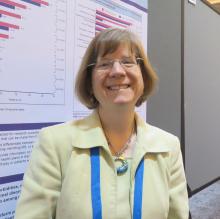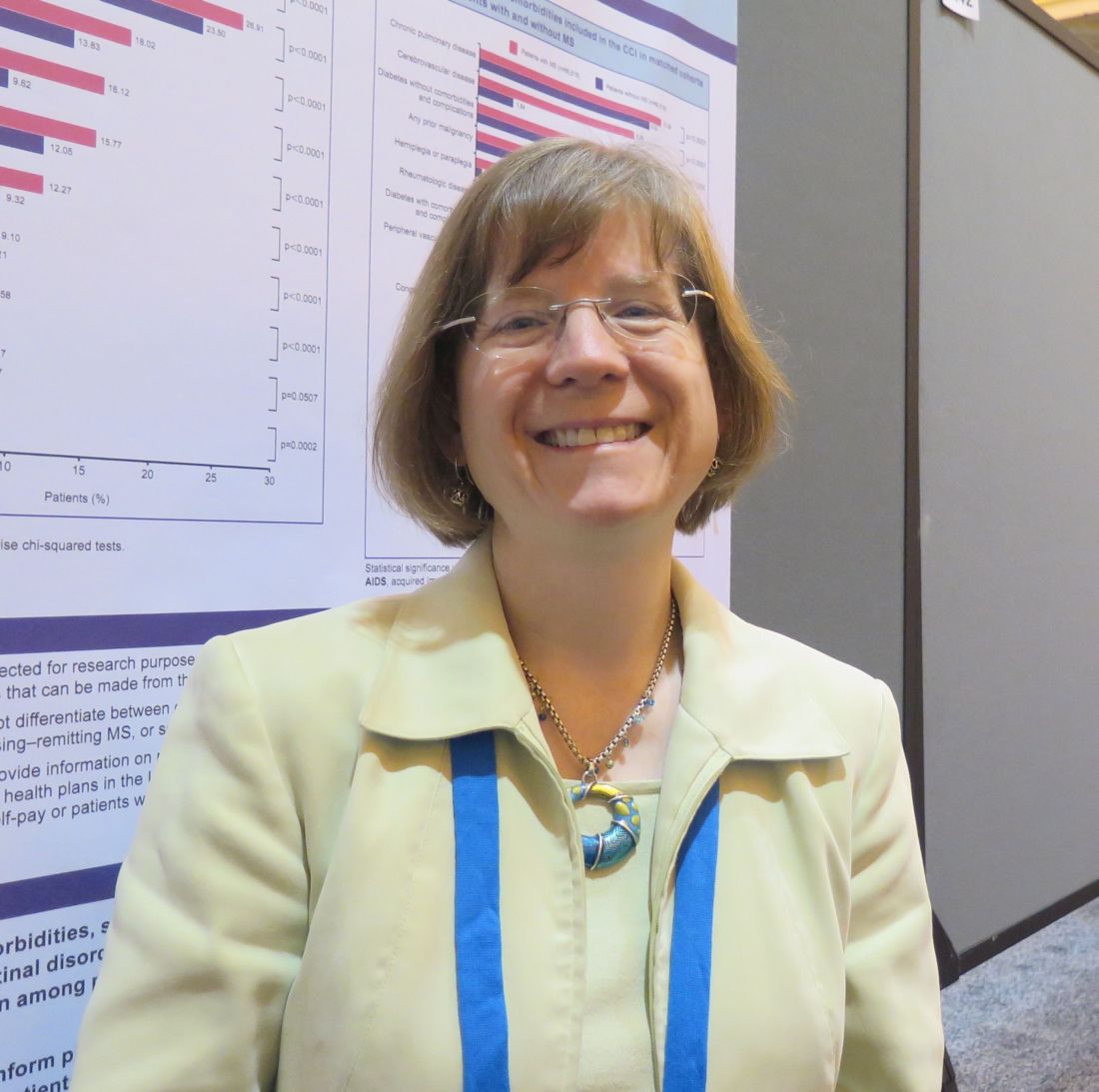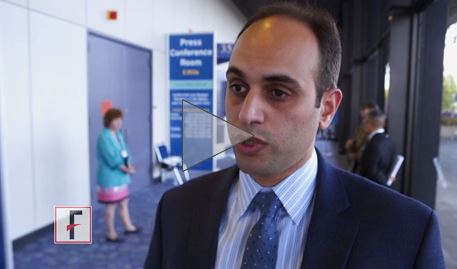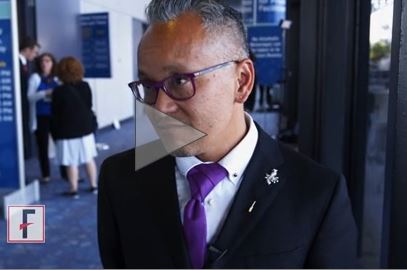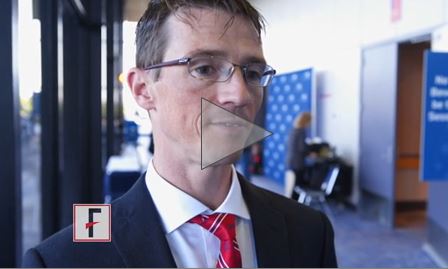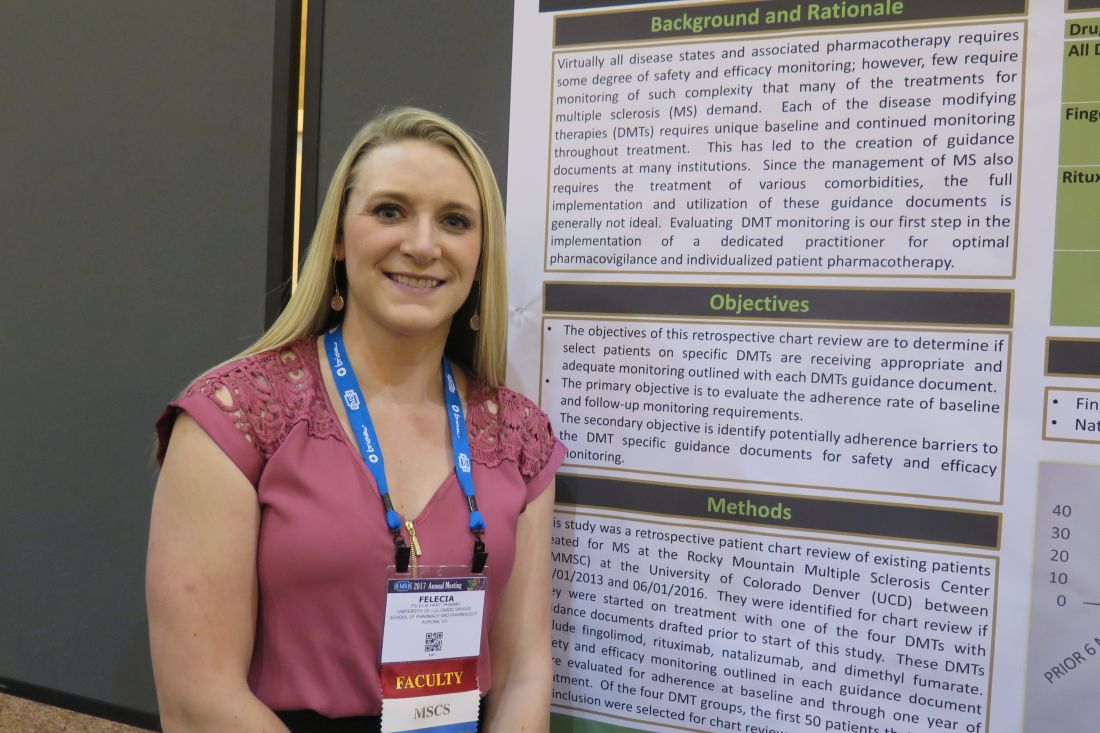User login
Study offers snapshot of common MS comorbidities
NEW ORLEANS – Comorbidities such as hyperlipidemia, hypertension, gastrointestinal disorders, and depression are significantly more common among patients with multiple sclerosis, compared with patients who do not have the condition.
The findings, based on a large analysis of national claims data that was presented at the annual meeting of the Consortium of Multiple Sclerosis Centers, may better inform physicians and patients about potential comorbidities in patients with MS, lead study author Kiren Kresa-Reahl, MD, said in an interview. “The challenge is, what is the underlying problem?” she asked. “Is it the chicken or the egg? It may be that MS lesions on the brain and microvascular disease look similar, so it’s hard to know. There are also conditions that are caused by MS, such as depression. Is it caused by MS the disease or is it a comorbidity with MS? That’s hard to know.”
In an effort to compare the prevalence of comorbidities in patients with and without MS, Dr. Kresa-Reahl and her associates retrospectively evaluated IMS Health Real World Data Adjudicated Claims-U.S. data between Jan. 1, 2011, and Sept. 30, 2015. The database includes about 150 million patients with a medical benefit and a subset of 95 million patients with both medical and pharmacy benefits. MS patients were required to have at least two claims with an ICD-9 diagnosis of MS 30 days apart and to be between the ages of 18 and 65.
The researchers drew from a systematic review of the 10 most common comorbidities in MS (Mult Scler. 2015;21[3]:263-81) and then matched 69,550 MS patients to a pool of 3,129,573 patients without MS by age group, gender, geographic region, and index quarter year. This left 66,616 patients in each cohort. Their mean age was 46 years, 76% were female, and the majority had commercial health insurance (97% of MS patients and 95% of those without the condition).
Of the 10 common comorbidities, eight occurred significantly more frequently among MS patients, compared with those without the condition (P less than .0001 for all). These included hyperlipidemia (27.76% vs. 24.57%, respectively), hypertension (26.91% vs. 23.50%), GI disorders (18.02% vs. 13.84%), depression (16.12% vs. 9.62%), thyroid disease (15.77% vs. 12.05%), anxiety (12.27% vs. 9.32%), and chronic obstructive pulmonary disease (10.39% vs. 9.52%).
Dr. Kresa-Reahl, a neurologist at the Providence Multiple Sclerosis Center in Portland, Ore., and her associates also found that patients with MS had a significantly lower prevalence of alcohol abuse, AIDS, mild liver disease, and moderate liver disease than did patients without MS (P less than .05 for all). There were no differences between groups in the prevalence of diabetes without complications or in metastatic tumor (P greater than .05).
She acknowledged certain limitations of the study, including the potential for missing information and the inability of the researchers to determine which form of MS the patients had. “It might be that if we looked at just Medicare and Medicaid patients, these diagnoses would be a little bit different,” Dr. Kresa-Reahl added. “Maybe they would have more disability or more depression or more limited mobility. It’s hard to know, but this is a snapshot of people who have commercial insurance, so maybe they would be more likely to be employed.”
The study was sponsored by EMD Serono. Dr. Kresa-Reahl disclosed that she has received consulting fees from Biogen and EMD Serono; speakers fees and honoraria from Biogen, EMD Serono, Genzyme, Mallinckrodt, Novartis, and Teva; and grant/research support from Biogen, Genentech, Genzyme, Mallinckrodt, and Novartis.
NEW ORLEANS – Comorbidities such as hyperlipidemia, hypertension, gastrointestinal disorders, and depression are significantly more common among patients with multiple sclerosis, compared with patients who do not have the condition.
The findings, based on a large analysis of national claims data that was presented at the annual meeting of the Consortium of Multiple Sclerosis Centers, may better inform physicians and patients about potential comorbidities in patients with MS, lead study author Kiren Kresa-Reahl, MD, said in an interview. “The challenge is, what is the underlying problem?” she asked. “Is it the chicken or the egg? It may be that MS lesions on the brain and microvascular disease look similar, so it’s hard to know. There are also conditions that are caused by MS, such as depression. Is it caused by MS the disease or is it a comorbidity with MS? That’s hard to know.”
In an effort to compare the prevalence of comorbidities in patients with and without MS, Dr. Kresa-Reahl and her associates retrospectively evaluated IMS Health Real World Data Adjudicated Claims-U.S. data between Jan. 1, 2011, and Sept. 30, 2015. The database includes about 150 million patients with a medical benefit and a subset of 95 million patients with both medical and pharmacy benefits. MS patients were required to have at least two claims with an ICD-9 diagnosis of MS 30 days apart and to be between the ages of 18 and 65.
The researchers drew from a systematic review of the 10 most common comorbidities in MS (Mult Scler. 2015;21[3]:263-81) and then matched 69,550 MS patients to a pool of 3,129,573 patients without MS by age group, gender, geographic region, and index quarter year. This left 66,616 patients in each cohort. Their mean age was 46 years, 76% were female, and the majority had commercial health insurance (97% of MS patients and 95% of those without the condition).
Of the 10 common comorbidities, eight occurred significantly more frequently among MS patients, compared with those without the condition (P less than .0001 for all). These included hyperlipidemia (27.76% vs. 24.57%, respectively), hypertension (26.91% vs. 23.50%), GI disorders (18.02% vs. 13.84%), depression (16.12% vs. 9.62%), thyroid disease (15.77% vs. 12.05%), anxiety (12.27% vs. 9.32%), and chronic obstructive pulmonary disease (10.39% vs. 9.52%).
Dr. Kresa-Reahl, a neurologist at the Providence Multiple Sclerosis Center in Portland, Ore., and her associates also found that patients with MS had a significantly lower prevalence of alcohol abuse, AIDS, mild liver disease, and moderate liver disease than did patients without MS (P less than .05 for all). There were no differences between groups in the prevalence of diabetes without complications or in metastatic tumor (P greater than .05).
She acknowledged certain limitations of the study, including the potential for missing information and the inability of the researchers to determine which form of MS the patients had. “It might be that if we looked at just Medicare and Medicaid patients, these diagnoses would be a little bit different,” Dr. Kresa-Reahl added. “Maybe they would have more disability or more depression or more limited mobility. It’s hard to know, but this is a snapshot of people who have commercial insurance, so maybe they would be more likely to be employed.”
The study was sponsored by EMD Serono. Dr. Kresa-Reahl disclosed that she has received consulting fees from Biogen and EMD Serono; speakers fees and honoraria from Biogen, EMD Serono, Genzyme, Mallinckrodt, Novartis, and Teva; and grant/research support from Biogen, Genentech, Genzyme, Mallinckrodt, and Novartis.
NEW ORLEANS – Comorbidities such as hyperlipidemia, hypertension, gastrointestinal disorders, and depression are significantly more common among patients with multiple sclerosis, compared with patients who do not have the condition.
The findings, based on a large analysis of national claims data that was presented at the annual meeting of the Consortium of Multiple Sclerosis Centers, may better inform physicians and patients about potential comorbidities in patients with MS, lead study author Kiren Kresa-Reahl, MD, said in an interview. “The challenge is, what is the underlying problem?” she asked. “Is it the chicken or the egg? It may be that MS lesions on the brain and microvascular disease look similar, so it’s hard to know. There are also conditions that are caused by MS, such as depression. Is it caused by MS the disease or is it a comorbidity with MS? That’s hard to know.”
In an effort to compare the prevalence of comorbidities in patients with and without MS, Dr. Kresa-Reahl and her associates retrospectively evaluated IMS Health Real World Data Adjudicated Claims-U.S. data between Jan. 1, 2011, and Sept. 30, 2015. The database includes about 150 million patients with a medical benefit and a subset of 95 million patients with both medical and pharmacy benefits. MS patients were required to have at least two claims with an ICD-9 diagnosis of MS 30 days apart and to be between the ages of 18 and 65.
The researchers drew from a systematic review of the 10 most common comorbidities in MS (Mult Scler. 2015;21[3]:263-81) and then matched 69,550 MS patients to a pool of 3,129,573 patients without MS by age group, gender, geographic region, and index quarter year. This left 66,616 patients in each cohort. Their mean age was 46 years, 76% were female, and the majority had commercial health insurance (97% of MS patients and 95% of those without the condition).
Of the 10 common comorbidities, eight occurred significantly more frequently among MS patients, compared with those without the condition (P less than .0001 for all). These included hyperlipidemia (27.76% vs. 24.57%, respectively), hypertension (26.91% vs. 23.50%), GI disorders (18.02% vs. 13.84%), depression (16.12% vs. 9.62%), thyroid disease (15.77% vs. 12.05%), anxiety (12.27% vs. 9.32%), and chronic obstructive pulmonary disease (10.39% vs. 9.52%).
Dr. Kresa-Reahl, a neurologist at the Providence Multiple Sclerosis Center in Portland, Ore., and her associates also found that patients with MS had a significantly lower prevalence of alcohol abuse, AIDS, mild liver disease, and moderate liver disease than did patients without MS (P less than .05 for all). There were no differences between groups in the prevalence of diabetes without complications or in metastatic tumor (P greater than .05).
She acknowledged certain limitations of the study, including the potential for missing information and the inability of the researchers to determine which form of MS the patients had. “It might be that if we looked at just Medicare and Medicaid patients, these diagnoses would be a little bit different,” Dr. Kresa-Reahl added. “Maybe they would have more disability or more depression or more limited mobility. It’s hard to know, but this is a snapshot of people who have commercial insurance, so maybe they would be more likely to be employed.”
The study was sponsored by EMD Serono. Dr. Kresa-Reahl disclosed that she has received consulting fees from Biogen and EMD Serono; speakers fees and honoraria from Biogen, EMD Serono, Genzyme, Mallinckrodt, Novartis, and Teva; and grant/research support from Biogen, Genentech, Genzyme, Mallinckrodt, and Novartis.
AT THE CMSC ANNUAL MEETING
Key clinical point:
Major finding: Of 10 common comorbidities, eight occurred significantly more frequently among MS patients, compared with those without the condition (P less than .0001 for all).
Data source: A retrospective analysis of claims data from 66,616 MS patients and 66,616 patients without the condition.
Disclosures: The study was sponsored by EMD Serono. Dr. Kresa-Reahl disclosed that she has received consulting fees from Biogen and EMD Serono; speakers fees and honoraria from Biogen, EMD Serono, Genzyme, Mallinckrodt, Novartis, and Teva; and grant/research support from Biogen, Genentech, Genzyme, Mallinckrodt, and Novartis.
Severe health conditions decline in childhood cancer survivors
CHICAGO – Severe health problems occurring 5 or more years after diagnosis of a childhood cancer have steadily declined, based on an analysis of 23,600 participants in the Childhood Cancer Survivor Study, funded by the National Institutes of Health.
For all childhood cancer survivors, the 15-year cumulative incidence of severe health conditions decreased from 12.7% in those diagnosed in the 1970s, to 10.1% in the 1980s, and to 8.8% among those diagnosed in the 1990s (per 10 years: hazard ratio, 0.84 [95% confidence interval, 0.80-0.89]), Todd M. Gibson, PhD, of St. Jude Children’s Research Hospital, Memphis, reported at a press conference at the annual meeting of the American Society of Clinical Oncology.
The association with diagnosis decade was attenuated (HR, 0.92 [95% CI, 0.85-1.00]) when detailed treatment data were included in the model, indicating that treatment reductions mediated risk.
Changes in childhood cancer treatment protocols to reduce the intensity of therapy – along with improved screening and early detection – have not only extended lifespan for many survivors, but also have reduced the incidence of serious chronic morbidity, Dr. Gibson said.
As the data address children diagnosed over 15 years ago, it is likely that improvements since then in determining patient risk and targeting therapy might result in further incremental improvements, he said in an interview.
By cancer type, severe health problems by 15 years after diagnosis decreased from 13% to 5% among survivors of Wilms’ tumor, from 18% to 11% among survivors of Hodgkin lymphoma, from 15% to 9% among survivors of astrocytoma, from 10% to 6% among survivors of non-Hodgkin lymphoma, and from 9% to 7% among survivors of acute lymphoblastic leukemia. The conclusions are based on the incidence of severe, disabling/life-threatening, or fatal chronic health conditions (Common Terminology Criteria for Adverse Events, grades 3-5) among 5-year survivors diagnosed prior to age 21 years from 1970 through 1999.
Adjusted for sex and attained age, significant reduction in risk over time was found among survivors of Wilms tumor (HR, 0.57 [95% CI, 0.46-0.70]), Hodgkin lymphoma (HR, 0.75 [95% CI, 0.65-0.85]), astrocytoma (HR, 0.77 [95% CI, 0.64-0.92]), non-Hodgkin lymphoma (HR, 0.79 [95% CI, 0.63-0.99]), and acute lymphoblastic leukemia (HR, 0.86 [95% CI, 0.76-0.98]).
The decreases in serious health conditions were largely driven by a reduced incidence of endocrine conditions (1970s: 4.0% vs. 1990s: 1.6%; HR, 0.66 [95% CI, 0.59-0.73]) and subsequent malignant neoplasms (1970s: 2.4% vs. 1990s: 1.6%; HR, 0.85 [95% CI, 0.76-0.96]).
Gastrointestinal (HR, 0.80 [95% CI, 0.66-0.97]) and neurological conditions (HR, 0.77 [95% CI, 0.65-0.91]) also were reduced, but cardiac and pulmonary conditions were not. Changes in childhood cancer treatment protocols have not only extended lifespan for many survivors, but also have reduced the incidence of serious chronic morbidity in this population, Dr. Gibson concluded.
[email protected]
On Twitter @maryjodales
CHICAGO – Severe health problems occurring 5 or more years after diagnosis of a childhood cancer have steadily declined, based on an analysis of 23,600 participants in the Childhood Cancer Survivor Study, funded by the National Institutes of Health.
For all childhood cancer survivors, the 15-year cumulative incidence of severe health conditions decreased from 12.7% in those diagnosed in the 1970s, to 10.1% in the 1980s, and to 8.8% among those diagnosed in the 1990s (per 10 years: hazard ratio, 0.84 [95% confidence interval, 0.80-0.89]), Todd M. Gibson, PhD, of St. Jude Children’s Research Hospital, Memphis, reported at a press conference at the annual meeting of the American Society of Clinical Oncology.
The association with diagnosis decade was attenuated (HR, 0.92 [95% CI, 0.85-1.00]) when detailed treatment data were included in the model, indicating that treatment reductions mediated risk.
Changes in childhood cancer treatment protocols to reduce the intensity of therapy – along with improved screening and early detection – have not only extended lifespan for many survivors, but also have reduced the incidence of serious chronic morbidity, Dr. Gibson said.
As the data address children diagnosed over 15 years ago, it is likely that improvements since then in determining patient risk and targeting therapy might result in further incremental improvements, he said in an interview.
By cancer type, severe health problems by 15 years after diagnosis decreased from 13% to 5% among survivors of Wilms’ tumor, from 18% to 11% among survivors of Hodgkin lymphoma, from 15% to 9% among survivors of astrocytoma, from 10% to 6% among survivors of non-Hodgkin lymphoma, and from 9% to 7% among survivors of acute lymphoblastic leukemia. The conclusions are based on the incidence of severe, disabling/life-threatening, or fatal chronic health conditions (Common Terminology Criteria for Adverse Events, grades 3-5) among 5-year survivors diagnosed prior to age 21 years from 1970 through 1999.
Adjusted for sex and attained age, significant reduction in risk over time was found among survivors of Wilms tumor (HR, 0.57 [95% CI, 0.46-0.70]), Hodgkin lymphoma (HR, 0.75 [95% CI, 0.65-0.85]), astrocytoma (HR, 0.77 [95% CI, 0.64-0.92]), non-Hodgkin lymphoma (HR, 0.79 [95% CI, 0.63-0.99]), and acute lymphoblastic leukemia (HR, 0.86 [95% CI, 0.76-0.98]).
The decreases in serious health conditions were largely driven by a reduced incidence of endocrine conditions (1970s: 4.0% vs. 1990s: 1.6%; HR, 0.66 [95% CI, 0.59-0.73]) and subsequent malignant neoplasms (1970s: 2.4% vs. 1990s: 1.6%; HR, 0.85 [95% CI, 0.76-0.96]).
Gastrointestinal (HR, 0.80 [95% CI, 0.66-0.97]) and neurological conditions (HR, 0.77 [95% CI, 0.65-0.91]) also were reduced, but cardiac and pulmonary conditions were not. Changes in childhood cancer treatment protocols have not only extended lifespan for many survivors, but also have reduced the incidence of serious chronic morbidity in this population, Dr. Gibson concluded.
[email protected]
On Twitter @maryjodales
CHICAGO – Severe health problems occurring 5 or more years after diagnosis of a childhood cancer have steadily declined, based on an analysis of 23,600 participants in the Childhood Cancer Survivor Study, funded by the National Institutes of Health.
For all childhood cancer survivors, the 15-year cumulative incidence of severe health conditions decreased from 12.7% in those diagnosed in the 1970s, to 10.1% in the 1980s, and to 8.8% among those diagnosed in the 1990s (per 10 years: hazard ratio, 0.84 [95% confidence interval, 0.80-0.89]), Todd M. Gibson, PhD, of St. Jude Children’s Research Hospital, Memphis, reported at a press conference at the annual meeting of the American Society of Clinical Oncology.
The association with diagnosis decade was attenuated (HR, 0.92 [95% CI, 0.85-1.00]) when detailed treatment data were included in the model, indicating that treatment reductions mediated risk.
Changes in childhood cancer treatment protocols to reduce the intensity of therapy – along with improved screening and early detection – have not only extended lifespan for many survivors, but also have reduced the incidence of serious chronic morbidity, Dr. Gibson said.
As the data address children diagnosed over 15 years ago, it is likely that improvements since then in determining patient risk and targeting therapy might result in further incremental improvements, he said in an interview.
By cancer type, severe health problems by 15 years after diagnosis decreased from 13% to 5% among survivors of Wilms’ tumor, from 18% to 11% among survivors of Hodgkin lymphoma, from 15% to 9% among survivors of astrocytoma, from 10% to 6% among survivors of non-Hodgkin lymphoma, and from 9% to 7% among survivors of acute lymphoblastic leukemia. The conclusions are based on the incidence of severe, disabling/life-threatening, or fatal chronic health conditions (Common Terminology Criteria for Adverse Events, grades 3-5) among 5-year survivors diagnosed prior to age 21 years from 1970 through 1999.
Adjusted for sex and attained age, significant reduction in risk over time was found among survivors of Wilms tumor (HR, 0.57 [95% CI, 0.46-0.70]), Hodgkin lymphoma (HR, 0.75 [95% CI, 0.65-0.85]), astrocytoma (HR, 0.77 [95% CI, 0.64-0.92]), non-Hodgkin lymphoma (HR, 0.79 [95% CI, 0.63-0.99]), and acute lymphoblastic leukemia (HR, 0.86 [95% CI, 0.76-0.98]).
The decreases in serious health conditions were largely driven by a reduced incidence of endocrine conditions (1970s: 4.0% vs. 1990s: 1.6%; HR, 0.66 [95% CI, 0.59-0.73]) and subsequent malignant neoplasms (1970s: 2.4% vs. 1990s: 1.6%; HR, 0.85 [95% CI, 0.76-0.96]).
Gastrointestinal (HR, 0.80 [95% CI, 0.66-0.97]) and neurological conditions (HR, 0.77 [95% CI, 0.65-0.91]) also were reduced, but cardiac and pulmonary conditions were not. Changes in childhood cancer treatment protocols have not only extended lifespan for many survivors, but also have reduced the incidence of serious chronic morbidity in this population, Dr. Gibson concluded.
[email protected]
On Twitter @maryjodales
AT ASCO 2017
Key clinical point:
Major finding: For all childhood cancer survivors, the 15-year cumulative incidence of severe health conditions decreased from 12.7% in those diagnosed in the 1970s, to 10.1% in the 1980s, and to 8.8% among those diagnosed in the 1990s (per 10 years: HR, 0.84 [95% CI, 0.80-0.89]).
Data source: An analysis of 23,600 participants in the Childhood Cancer Survivor Study.
Disclosures: The study was funded by the National Institutes of Health.
VIDEO: Low testosterone common after testicular cancer
CHICAGO – More than one-third of testicular cancer survivors have hypogonadism, according to an analysis of nearly 500 male patients conducted by the Platinum Study Group.
Lead author Mohammad Abu Zaid, MBBS, of Indiana University, Indianapolis, discusses the implications for long-term health, screening during follow-up, testing, and testosterone replacement therapy in a video interview at the annual meeting of the American Society of Clinical Oncology.
The video associated with this article is no longer available on this site. Please view all of our videos on the MDedge YouTube channel
CHICAGO – More than one-third of testicular cancer survivors have hypogonadism, according to an analysis of nearly 500 male patients conducted by the Platinum Study Group.
Lead author Mohammad Abu Zaid, MBBS, of Indiana University, Indianapolis, discusses the implications for long-term health, screening during follow-up, testing, and testosterone replacement therapy in a video interview at the annual meeting of the American Society of Clinical Oncology.
The video associated with this article is no longer available on this site. Please view all of our videos on the MDedge YouTube channel
CHICAGO – More than one-third of testicular cancer survivors have hypogonadism, according to an analysis of nearly 500 male patients conducted by the Platinum Study Group.
Lead author Mohammad Abu Zaid, MBBS, of Indiana University, Indianapolis, discusses the implications for long-term health, screening during follow-up, testing, and testosterone replacement therapy in a video interview at the annual meeting of the American Society of Clinical Oncology.
The video associated with this article is no longer available on this site. Please view all of our videos on the MDedge YouTube channel
AT ASCO 2017
VIDEO: Single dose of RT suffices, but will radiation oncologists adopt the strategy?
CHICAGO – The randomized SCORAD III trial shows that a single 8-Gy dose of radiation therapy has efficacy similar to that of a 20-Gy dose given over the course of a week for treating metastatic spinal cord compression in patients with modest survival, first author Peter Hoskin, MD, FCRP, FRCR, said in a video interview at the annual meeting of the American Society of Clinical Oncology. But will radiation oncologists adopt this new strategy?
The video associated with this article is no longer available on this site. Please view all of our videos on the MDedge YouTube channel
CHICAGO – The randomized SCORAD III trial shows that a single 8-Gy dose of radiation therapy has efficacy similar to that of a 20-Gy dose given over the course of a week for treating metastatic spinal cord compression in patients with modest survival, first author Peter Hoskin, MD, FCRP, FRCR, said in a video interview at the annual meeting of the American Society of Clinical Oncology. But will radiation oncologists adopt this new strategy?
The video associated with this article is no longer available on this site. Please view all of our videos on the MDedge YouTube channel
CHICAGO – The randomized SCORAD III trial shows that a single 8-Gy dose of radiation therapy has efficacy similar to that of a 20-Gy dose given over the course of a week for treating metastatic spinal cord compression in patients with modest survival, first author Peter Hoskin, MD, FCRP, FRCR, said in a video interview at the annual meeting of the American Society of Clinical Oncology. But will radiation oncologists adopt this new strategy?
The video associated with this article is no longer available on this site. Please view all of our videos on the MDedge YouTube channel
AT ASCO 2017
VIDEO: Helping cancer patients cope with psychological side effects
CHICAGO – Oncologists are highly skilled at minimizing side effects associated with toxic but curative therapies, but are less adept at helping patients cope with the distress, anxiety, fear, and other emotions associated with cancer.
Three studies presented at the annual meeting of the American Society of Clinical Oncology detail randomized, controlled trials of psychological interventions aimed at helping patients cope with a new cancer diagnosis, reduce fears of a recurrence, and come to grips with the realities of advanced disease, including fears of death or disability.
Don S. Dizon, MD, from the Massachusetts General Hospital Cancer Center, Boston, discusses the social and financial barriers that cancer patients face when they experience distress, and the difficulties that providers face with limited time and financial resources to help patients cope in this video interview.
Dr. Dizon reported having no relevant disclosures.
The video associated with this article is no longer available on this site. Please view all of our videos on the MDedge YouTube channel
CHICAGO – Oncologists are highly skilled at minimizing side effects associated with toxic but curative therapies, but are less adept at helping patients cope with the distress, anxiety, fear, and other emotions associated with cancer.
Three studies presented at the annual meeting of the American Society of Clinical Oncology detail randomized, controlled trials of psychological interventions aimed at helping patients cope with a new cancer diagnosis, reduce fears of a recurrence, and come to grips with the realities of advanced disease, including fears of death or disability.
Don S. Dizon, MD, from the Massachusetts General Hospital Cancer Center, Boston, discusses the social and financial barriers that cancer patients face when they experience distress, and the difficulties that providers face with limited time and financial resources to help patients cope in this video interview.
Dr. Dizon reported having no relevant disclosures.
The video associated with this article is no longer available on this site. Please view all of our videos on the MDedge YouTube channel
CHICAGO – Oncologists are highly skilled at minimizing side effects associated with toxic but curative therapies, but are less adept at helping patients cope with the distress, anxiety, fear, and other emotions associated with cancer.
Three studies presented at the annual meeting of the American Society of Clinical Oncology detail randomized, controlled trials of psychological interventions aimed at helping patients cope with a new cancer diagnosis, reduce fears of a recurrence, and come to grips with the realities of advanced disease, including fears of death or disability.
Don S. Dizon, MD, from the Massachusetts General Hospital Cancer Center, Boston, discusses the social and financial barriers that cancer patients face when they experience distress, and the difficulties that providers face with limited time and financial resources to help patients cope in this video interview.
Dr. Dizon reported having no relevant disclosures.
The video associated with this article is no longer available on this site. Please view all of our videos on the MDedge YouTube channel
AT ASCO 2017
VIDEO: Childhood cancer survivors living longer with fewer severe health problems
CHICAGO – Severe health problems occurring 5 or more years after diagnosis of a childhood cancer have been steadily declining, based on an analysis of 23,600 participants in the Childhood Cancer Survivor Study (CCSS), funded by the National Institutes of Health.
Watch our video interview with lead author Todd M. Gibson, PhD, of St. Jude Children’s Research Hospital, Memphis, who reported the data at a press conference at the annual meeting of the American Society of Clinical Oncology.
The video associated with this article is no longer available on this site. Please view all of our videos on the MDedge YouTube channel
[email protected]
On Twitter @maryjodales
CHICAGO – Severe health problems occurring 5 or more years after diagnosis of a childhood cancer have been steadily declining, based on an analysis of 23,600 participants in the Childhood Cancer Survivor Study (CCSS), funded by the National Institutes of Health.
Watch our video interview with lead author Todd M. Gibson, PhD, of St. Jude Children’s Research Hospital, Memphis, who reported the data at a press conference at the annual meeting of the American Society of Clinical Oncology.
The video associated with this article is no longer available on this site. Please view all of our videos on the MDedge YouTube channel
[email protected]
On Twitter @maryjodales
CHICAGO – Severe health problems occurring 5 or more years after diagnosis of a childhood cancer have been steadily declining, based on an analysis of 23,600 participants in the Childhood Cancer Survivor Study (CCSS), funded by the National Institutes of Health.
Watch our video interview with lead author Todd M. Gibson, PhD, of St. Jude Children’s Research Hospital, Memphis, who reported the data at a press conference at the annual meeting of the American Society of Clinical Oncology.
The video associated with this article is no longer available on this site. Please view all of our videos on the MDedge YouTube channel
[email protected]
On Twitter @maryjodales
AT ASCO 2017
Differences emerge in new guidelines for managing FN in kids
A multidisciplinary, international panel of experts has updated earlier clinical practice guidelines on managing fever and neutropenia (FN) in children with cancer and in those undergoing hematopoietic stem cell transplantation (HSCT). And while most of the recommendations remained unchanged from the 2012 guidelines, a few key differences emerged. The changes included addition of a 4th generation cephalosporin for empirical antifungal therapy and refinements in risk stratification for invasive fungal disease (IFD), among others.
The new guidelines were published by The International Pediatric Fever and Neutropenia Guideline Panel in the Journal of Clinical Oncology.
The recommendations were organized into 3 major sections: initial presentation, ongoing management, and empirical antifungal therapy. The guidelines panel followed procedures previously validated for creating evidence-based guidelines and used the Appraisal of Guidelines for Research & Evaluation II instrument as a framework.
For the initial presentation of FN, the panel increased the quality of evidence from low to moderate in the recommendation to obtain peripheral blood cultures concurrent with central venous catheter cultures.
In the treatment of FN, the panel added a 4th-generation cephalosporin as empirical therapy in high-risk FN.
The panel refined the IFD risk factors and decreased the quality of evidence from moderate to low. Children with acute myeloid leukemia (AML), high-risk acute lymphoblastic leukemia (ALL), relapsed acute leukemia, those undergoing allogeneic HSCT, those with prolonged neutropenia, and those receiving high-dose corticosteroids are at high risk of IFD. All others should be categorized as IFD low risk.
The panel suggested serum galactomannan not be used to guide empirical antifungal management for prolonged FN lasting 96 hours or more in high-risk IFD patients. GM does not rule out non-Aspergillus molds, and therefore high negative values provide less useful predictions. Previously, the use of galactomannan was a weak recommendation.
The panel added a new recommendation against using fungal polymerase chain reaction (PCR) testing in blood. They explained PCR testing provides poor positive predictive values and negative predictive values are not sufficiently high to be clinically useful. Also, PCR testing is not yet standardized.
Another new recommendation is the addition of imaging of the abdomen in patients without localizing signs or symptoms. Even though the ideal imaging modality is not known, ultrasound is readily available, not associated with radiation exposure, and usually does not require sedation. For these reasons, the panel said it is preferable to computed tomography or magnetic resonance imaging.
The panel also changed a previously weak recommendation to administer empirical therapy for IFD low-risk patients with prolonged FN to a weak recommendation against administering therapy for these patients.
The panel's recommendations and their rationale can be found in the JCO article.
The guidelines update was supported by meeting grants from the Canadian Institutes of Health Research and the Garron Comprehensive Cancer Centre. ![]()
A multidisciplinary, international panel of experts has updated earlier clinical practice guidelines on managing fever and neutropenia (FN) in children with cancer and in those undergoing hematopoietic stem cell transplantation (HSCT). And while most of the recommendations remained unchanged from the 2012 guidelines, a few key differences emerged. The changes included addition of a 4th generation cephalosporin for empirical antifungal therapy and refinements in risk stratification for invasive fungal disease (IFD), among others.
The new guidelines were published by The International Pediatric Fever and Neutropenia Guideline Panel in the Journal of Clinical Oncology.
The recommendations were organized into 3 major sections: initial presentation, ongoing management, and empirical antifungal therapy. The guidelines panel followed procedures previously validated for creating evidence-based guidelines and used the Appraisal of Guidelines for Research & Evaluation II instrument as a framework.
For the initial presentation of FN, the panel increased the quality of evidence from low to moderate in the recommendation to obtain peripheral blood cultures concurrent with central venous catheter cultures.
In the treatment of FN, the panel added a 4th-generation cephalosporin as empirical therapy in high-risk FN.
The panel refined the IFD risk factors and decreased the quality of evidence from moderate to low. Children with acute myeloid leukemia (AML), high-risk acute lymphoblastic leukemia (ALL), relapsed acute leukemia, those undergoing allogeneic HSCT, those with prolonged neutropenia, and those receiving high-dose corticosteroids are at high risk of IFD. All others should be categorized as IFD low risk.
The panel suggested serum galactomannan not be used to guide empirical antifungal management for prolonged FN lasting 96 hours or more in high-risk IFD patients. GM does not rule out non-Aspergillus molds, and therefore high negative values provide less useful predictions. Previously, the use of galactomannan was a weak recommendation.
The panel added a new recommendation against using fungal polymerase chain reaction (PCR) testing in blood. They explained PCR testing provides poor positive predictive values and negative predictive values are not sufficiently high to be clinically useful. Also, PCR testing is not yet standardized.
Another new recommendation is the addition of imaging of the abdomen in patients without localizing signs or symptoms. Even though the ideal imaging modality is not known, ultrasound is readily available, not associated with radiation exposure, and usually does not require sedation. For these reasons, the panel said it is preferable to computed tomography or magnetic resonance imaging.
The panel also changed a previously weak recommendation to administer empirical therapy for IFD low-risk patients with prolonged FN to a weak recommendation against administering therapy for these patients.
The panel's recommendations and their rationale can be found in the JCO article.
The guidelines update was supported by meeting grants from the Canadian Institutes of Health Research and the Garron Comprehensive Cancer Centre. ![]()
A multidisciplinary, international panel of experts has updated earlier clinical practice guidelines on managing fever and neutropenia (FN) in children with cancer and in those undergoing hematopoietic stem cell transplantation (HSCT). And while most of the recommendations remained unchanged from the 2012 guidelines, a few key differences emerged. The changes included addition of a 4th generation cephalosporin for empirical antifungal therapy and refinements in risk stratification for invasive fungal disease (IFD), among others.
The new guidelines were published by The International Pediatric Fever and Neutropenia Guideline Panel in the Journal of Clinical Oncology.
The recommendations were organized into 3 major sections: initial presentation, ongoing management, and empirical antifungal therapy. The guidelines panel followed procedures previously validated for creating evidence-based guidelines and used the Appraisal of Guidelines for Research & Evaluation II instrument as a framework.
For the initial presentation of FN, the panel increased the quality of evidence from low to moderate in the recommendation to obtain peripheral blood cultures concurrent with central venous catheter cultures.
In the treatment of FN, the panel added a 4th-generation cephalosporin as empirical therapy in high-risk FN.
The panel refined the IFD risk factors and decreased the quality of evidence from moderate to low. Children with acute myeloid leukemia (AML), high-risk acute lymphoblastic leukemia (ALL), relapsed acute leukemia, those undergoing allogeneic HSCT, those with prolonged neutropenia, and those receiving high-dose corticosteroids are at high risk of IFD. All others should be categorized as IFD low risk.
The panel suggested serum galactomannan not be used to guide empirical antifungal management for prolonged FN lasting 96 hours or more in high-risk IFD patients. GM does not rule out non-Aspergillus molds, and therefore high negative values provide less useful predictions. Previously, the use of galactomannan was a weak recommendation.
The panel added a new recommendation against using fungal polymerase chain reaction (PCR) testing in blood. They explained PCR testing provides poor positive predictive values and negative predictive values are not sufficiently high to be clinically useful. Also, PCR testing is not yet standardized.
Another new recommendation is the addition of imaging of the abdomen in patients without localizing signs or symptoms. Even though the ideal imaging modality is not known, ultrasound is readily available, not associated with radiation exposure, and usually does not require sedation. For these reasons, the panel said it is preferable to computed tomography or magnetic resonance imaging.
The panel also changed a previously weak recommendation to administer empirical therapy for IFD low-risk patients with prolonged FN to a weak recommendation against administering therapy for these patients.
The panel's recommendations and their rationale can be found in the JCO article.
The guidelines update was supported by meeting grants from the Canadian Institutes of Health Research and the Garron Comprehensive Cancer Centre. ![]()
Access to ‘the little blue book’ just got a lot more expensive
“The little blue book” has been an office standard as long as I’ve been in practice. Every practice has a dog-eared copy in a drawer somewhere that’s constantly being pulled out to look up hospitals, other doctors, and pharmacies.
As small as it is, it’s pretty useful in the daily flow of my office routine.
Until now.
Sadly, 2016 was apparently the year I ordered my last copies. The publisher’s marketing people inform me that the paper version has been discontinued, and I can now get the digital version for only ... $500 per year.
Thanks, but no thanks.
I have nothing against digital editions. In fact, if it was the same price as the paper one, I’d get it. If I were a big practice that needed, say, 50 copies for the staff, the $500 per practice fee is a deal, compared with the $998 I’d pay for 50 paper copies.
But for my dinky little two-person practice? The difference between $39.90 and $500 just isn’t worth all the advantages a digital version may offer. For that kind of money, I’ll use Google.
This is another part of a gradual, and disturbing, trend in medicine: ignoring small practices. Large corporate practices are worth a lot more in sales than little one-to-three doctor groups, so companies, such as “the little blue book,” have no incentive to tailor their products to us. We have become medical persona non grata.
I understand this is a business decision. It’s not specifically directed at me.
Yet ...
I’ve been in practice for almost 20 years now, and buying two copies of the LBB is something I’ve done annually, in good and bad economic years. I’ve supported the publisher because it was a good product at a fair price. Sadly, they no longer find my little practice to be worth the effort or profit margin.
Dr. Block has a solo neurology practice in Scottsdale, Ariz.
“The little blue book” has been an office standard as long as I’ve been in practice. Every practice has a dog-eared copy in a drawer somewhere that’s constantly being pulled out to look up hospitals, other doctors, and pharmacies.
As small as it is, it’s pretty useful in the daily flow of my office routine.
Until now.
Sadly, 2016 was apparently the year I ordered my last copies. The publisher’s marketing people inform me that the paper version has been discontinued, and I can now get the digital version for only ... $500 per year.
Thanks, but no thanks.
I have nothing against digital editions. In fact, if it was the same price as the paper one, I’d get it. If I were a big practice that needed, say, 50 copies for the staff, the $500 per practice fee is a deal, compared with the $998 I’d pay for 50 paper copies.
But for my dinky little two-person practice? The difference between $39.90 and $500 just isn’t worth all the advantages a digital version may offer. For that kind of money, I’ll use Google.
This is another part of a gradual, and disturbing, trend in medicine: ignoring small practices. Large corporate practices are worth a lot more in sales than little one-to-three doctor groups, so companies, such as “the little blue book,” have no incentive to tailor their products to us. We have become medical persona non grata.
I understand this is a business decision. It’s not specifically directed at me.
Yet ...
I’ve been in practice for almost 20 years now, and buying two copies of the LBB is something I’ve done annually, in good and bad economic years. I’ve supported the publisher because it was a good product at a fair price. Sadly, they no longer find my little practice to be worth the effort or profit margin.
Dr. Block has a solo neurology practice in Scottsdale, Ariz.
“The little blue book” has been an office standard as long as I’ve been in practice. Every practice has a dog-eared copy in a drawer somewhere that’s constantly being pulled out to look up hospitals, other doctors, and pharmacies.
As small as it is, it’s pretty useful in the daily flow of my office routine.
Until now.
Sadly, 2016 was apparently the year I ordered my last copies. The publisher’s marketing people inform me that the paper version has been discontinued, and I can now get the digital version for only ... $500 per year.
Thanks, but no thanks.
I have nothing against digital editions. In fact, if it was the same price as the paper one, I’d get it. If I were a big practice that needed, say, 50 copies for the staff, the $500 per practice fee is a deal, compared with the $998 I’d pay for 50 paper copies.
But for my dinky little two-person practice? The difference between $39.90 and $500 just isn’t worth all the advantages a digital version may offer. For that kind of money, I’ll use Google.
This is another part of a gradual, and disturbing, trend in medicine: ignoring small practices. Large corporate practices are worth a lot more in sales than little one-to-three doctor groups, so companies, such as “the little blue book,” have no incentive to tailor their products to us. We have become medical persona non grata.
I understand this is a business decision. It’s not specifically directed at me.
Yet ...
I’ve been in practice for almost 20 years now, and buying two copies of the LBB is something I’ve done annually, in good and bad economic years. I’ve supported the publisher because it was a good product at a fair price. Sadly, they no longer find my little practice to be worth the effort or profit margin.
Dr. Block has a solo neurology practice in Scottsdale, Ariz.
Effective monitoring of DMTs for multiple sclerosis can be tricky
NEW ORLEANS – Safety and efficacy laboratory monitoring of adherence to disease-modifying therapies for multiple sclerosis remains challenging, results from a small pilot study showed.
In an effort to determine if select patients on specific DMTs are receiving appropriate and adequate monitoring as outlined by each DMT’s internal guidance document, Felecia Hart, PharmD, and her associates retrospectively reviewed existing patients treated for MS at the Rocky Mountain Multiple Sclerosis Center at the University of Colorado, Denver, between June 1, 2013, and June 1, 2016.
“What we wanted to know was, if patients are getting their infusions or lab work done elsewhere, are we properly documenting it and keeping track of it?” Dr. Hart said in an interview at the meeting. “We’re not looking for core outcomes yet.”
Dr. Hart, a clinical pharmacy neurology fellow at the Skaggs School of Pharmacy and Pharmaceutical Sciences on the University of Colorado Anschutz Medical Campus, reported preliminary results from 50 patients treated with natalizumab and 50 treated with fingolimod. Among those treated with natalizumab, 49 had vitamin D measured within 6 months of drug initiation, 49 had a complete blood count measured within 1 year of drug initiation, and 49 had a comprehensive metabolic panel (CMP) measured within 1 year of drug initiation. “Interestingly, the absent CBC and CMP were from different patients,” she said.
Among patients treated with fingolimod, all had CBC/CMP measured within 1 year of drug initiation, 48 had vitamin D measured within 6 months of drug initiation, and 47 had documented macular optical coherence tomography at baseline, but the proportion of patients who had adequate documentation for other recommended assessments declined significantly. For example, only 19 of 50 had a documented repeat echocardiography within 3 months of drug initiation. Also, several baseline measurements required prior to drug initiation were documented poorly or in an untimely manner. Four patients had their HIV-1 and -2 antibody measured after drug initiation, three had hepatitis B virus surface antigen measured after drug initiation, and three had varicella measured after drug initiation.
Even though the MS center has an electronic medical record system, Dr. Hart and her associates found it difficult to obtain and monitor the parameters of interest. “I’ve been working with our EMR for 6 years, so I know how to navigate it well,” she said. “But I found it difficult to do a simple chart review and find what I wanted to. We have a labs tab in our chart, but the difficulty became including patients who were coming from outside of our center. The lab and the order were referenced in a note but there was never any documentation after that. There are too many holes in getting it documented correctly.”
The findings suggest that having a dedicated clinician such as a clinical pharmacist to oversee pharmacovigilance may improve patient outcomes and ensure that safety and efficacy monitoring doesn’t inadvertently get overlooked because of difficulties with adequate documentation. “That would be ideal,” Dr. Hart said.
She reported having no financial disclosures.
NEW ORLEANS – Safety and efficacy laboratory monitoring of adherence to disease-modifying therapies for multiple sclerosis remains challenging, results from a small pilot study showed.
In an effort to determine if select patients on specific DMTs are receiving appropriate and adequate monitoring as outlined by each DMT’s internal guidance document, Felecia Hart, PharmD, and her associates retrospectively reviewed existing patients treated for MS at the Rocky Mountain Multiple Sclerosis Center at the University of Colorado, Denver, between June 1, 2013, and June 1, 2016.
“What we wanted to know was, if patients are getting their infusions or lab work done elsewhere, are we properly documenting it and keeping track of it?” Dr. Hart said in an interview at the meeting. “We’re not looking for core outcomes yet.”
Dr. Hart, a clinical pharmacy neurology fellow at the Skaggs School of Pharmacy and Pharmaceutical Sciences on the University of Colorado Anschutz Medical Campus, reported preliminary results from 50 patients treated with natalizumab and 50 treated with fingolimod. Among those treated with natalizumab, 49 had vitamin D measured within 6 months of drug initiation, 49 had a complete blood count measured within 1 year of drug initiation, and 49 had a comprehensive metabolic panel (CMP) measured within 1 year of drug initiation. “Interestingly, the absent CBC and CMP were from different patients,” she said.
Among patients treated with fingolimod, all had CBC/CMP measured within 1 year of drug initiation, 48 had vitamin D measured within 6 months of drug initiation, and 47 had documented macular optical coherence tomography at baseline, but the proportion of patients who had adequate documentation for other recommended assessments declined significantly. For example, only 19 of 50 had a documented repeat echocardiography within 3 months of drug initiation. Also, several baseline measurements required prior to drug initiation were documented poorly or in an untimely manner. Four patients had their HIV-1 and -2 antibody measured after drug initiation, three had hepatitis B virus surface antigen measured after drug initiation, and three had varicella measured after drug initiation.
Even though the MS center has an electronic medical record system, Dr. Hart and her associates found it difficult to obtain and monitor the parameters of interest. “I’ve been working with our EMR for 6 years, so I know how to navigate it well,” she said. “But I found it difficult to do a simple chart review and find what I wanted to. We have a labs tab in our chart, but the difficulty became including patients who were coming from outside of our center. The lab and the order were referenced in a note but there was never any documentation after that. There are too many holes in getting it documented correctly.”
The findings suggest that having a dedicated clinician such as a clinical pharmacist to oversee pharmacovigilance may improve patient outcomes and ensure that safety and efficacy monitoring doesn’t inadvertently get overlooked because of difficulties with adequate documentation. “That would be ideal,” Dr. Hart said.
She reported having no financial disclosures.
NEW ORLEANS – Safety and efficacy laboratory monitoring of adherence to disease-modifying therapies for multiple sclerosis remains challenging, results from a small pilot study showed.
In an effort to determine if select patients on specific DMTs are receiving appropriate and adequate monitoring as outlined by each DMT’s internal guidance document, Felecia Hart, PharmD, and her associates retrospectively reviewed existing patients treated for MS at the Rocky Mountain Multiple Sclerosis Center at the University of Colorado, Denver, between June 1, 2013, and June 1, 2016.
“What we wanted to know was, if patients are getting their infusions or lab work done elsewhere, are we properly documenting it and keeping track of it?” Dr. Hart said in an interview at the meeting. “We’re not looking for core outcomes yet.”
Dr. Hart, a clinical pharmacy neurology fellow at the Skaggs School of Pharmacy and Pharmaceutical Sciences on the University of Colorado Anschutz Medical Campus, reported preliminary results from 50 patients treated with natalizumab and 50 treated with fingolimod. Among those treated with natalizumab, 49 had vitamin D measured within 6 months of drug initiation, 49 had a complete blood count measured within 1 year of drug initiation, and 49 had a comprehensive metabolic panel (CMP) measured within 1 year of drug initiation. “Interestingly, the absent CBC and CMP were from different patients,” she said.
Among patients treated with fingolimod, all had CBC/CMP measured within 1 year of drug initiation, 48 had vitamin D measured within 6 months of drug initiation, and 47 had documented macular optical coherence tomography at baseline, but the proportion of patients who had adequate documentation for other recommended assessments declined significantly. For example, only 19 of 50 had a documented repeat echocardiography within 3 months of drug initiation. Also, several baseline measurements required prior to drug initiation were documented poorly or in an untimely manner. Four patients had their HIV-1 and -2 antibody measured after drug initiation, three had hepatitis B virus surface antigen measured after drug initiation, and three had varicella measured after drug initiation.
Even though the MS center has an electronic medical record system, Dr. Hart and her associates found it difficult to obtain and monitor the parameters of interest. “I’ve been working with our EMR for 6 years, so I know how to navigate it well,” she said. “But I found it difficult to do a simple chart review and find what I wanted to. We have a labs tab in our chart, but the difficulty became including patients who were coming from outside of our center. The lab and the order were referenced in a note but there was never any documentation after that. There are too many holes in getting it documented correctly.”
The findings suggest that having a dedicated clinician such as a clinical pharmacist to oversee pharmacovigilance may improve patient outcomes and ensure that safety and efficacy monitoring doesn’t inadvertently get overlooked because of difficulties with adequate documentation. “That would be ideal,” Dr. Hart said.
She reported having no financial disclosures.
AT THE CMSC ANNUAL MEETING
Key clinical point:
Major finding: Among patients treated with fingolimod, only 19 of 50 had a documented repeat ECG within 3 months of drug initiation. Also, several baseline measurements required prior to drug initiation were documented poorly or in an untimely manner.
Data source: Preliminary results from a retrospective review of 50 patients treated with natalizumab and 50 treated with fingolimod.
Disclosures: Dr. Hart reported having no financial disclosures.
Lactulose plus albumin is more effective than lactulose alone for treatment of hepatic encephalopathy
Clinical Question: Is the combination of lactulose plus albumin more effective than lactulose alone for treatment of hepatic encephalopathy?
Background: Hepatic encephalopathy is caused by the effect of toxins that build up in the bloodstream when the liver is not able to perform its normal functions. Lactulose is primarily directed at the reduction of blood ammonia levels. Albumin is thought to minimize oxidative injury and improve circulatory dysfunction present in cirrhosis.
Setting: Tertiary care centers in India.
Synopsis: 120 patients with overt hepatic encephalopathy were randomized to treatment with lactulose plus albumin (1.5 gm/kg/day; n = 60), versus lactulose alone (n = 60). Patients with serum creatinine greater than 1.5 mg/dL on admission, active alcohol intake less than 4 weeks prior to presentation, other metabolic encephalopathies, or hepatocellular carcinoma were excluded. Treatment was continued up to a maximum of 10 days until complete resolution of hepatic encephalopathy as assessed independently by two expert hepatologists.
Of patients receiving lactulose plus albumin, 75% had complete reversal of hepatic encephalopathy within 10 days, compared with 53% of patients receiving lactulose alone (P = .03). Patients in lactulose plus albumin group had shorter hospital length-of-stay (6.4 vs. 8.6 days; P = .01). There was lower mortality at 10 days in the lactulose plus albumin group (18.3% vs. 31.6%; P = .04).
Limitations of the study include the noted exclusion factors, including presence of alcohol intake, limitation to a single country (India), and a relatively high mortality rate in both groups.
Bottom Line: Combination of lactulose plus albumin is more effective than lactulose alone at reversing hepatic encephalopathy and is also associated with decreased length-of-stay and mortality.
Reference: Sharma BC, Singh J, Srivastava S, et al. A randomized controlled trial comparing lactulose plus albumin with lactulose alone for treatment of hepatic encephalopathy. J Gastroenterol Hepatol. Published online Nov 25, 2016. doi: 10.1111/jgh.13666.
Dr. Huang is associate clinical professor in the division of hospital medicine, department of medicine, University of California, San Diego.
Clinical Question: Is the combination of lactulose plus albumin more effective than lactulose alone for treatment of hepatic encephalopathy?
Background: Hepatic encephalopathy is caused by the effect of toxins that build up in the bloodstream when the liver is not able to perform its normal functions. Lactulose is primarily directed at the reduction of blood ammonia levels. Albumin is thought to minimize oxidative injury and improve circulatory dysfunction present in cirrhosis.
Setting: Tertiary care centers in India.
Synopsis: 120 patients with overt hepatic encephalopathy were randomized to treatment with lactulose plus albumin (1.5 gm/kg/day; n = 60), versus lactulose alone (n = 60). Patients with serum creatinine greater than 1.5 mg/dL on admission, active alcohol intake less than 4 weeks prior to presentation, other metabolic encephalopathies, or hepatocellular carcinoma were excluded. Treatment was continued up to a maximum of 10 days until complete resolution of hepatic encephalopathy as assessed independently by two expert hepatologists.
Of patients receiving lactulose plus albumin, 75% had complete reversal of hepatic encephalopathy within 10 days, compared with 53% of patients receiving lactulose alone (P = .03). Patients in lactulose plus albumin group had shorter hospital length-of-stay (6.4 vs. 8.6 days; P = .01). There was lower mortality at 10 days in the lactulose plus albumin group (18.3% vs. 31.6%; P = .04).
Limitations of the study include the noted exclusion factors, including presence of alcohol intake, limitation to a single country (India), and a relatively high mortality rate in both groups.
Bottom Line: Combination of lactulose plus albumin is more effective than lactulose alone at reversing hepatic encephalopathy and is also associated with decreased length-of-stay and mortality.
Reference: Sharma BC, Singh J, Srivastava S, et al. A randomized controlled trial comparing lactulose plus albumin with lactulose alone for treatment of hepatic encephalopathy. J Gastroenterol Hepatol. Published online Nov 25, 2016. doi: 10.1111/jgh.13666.
Dr. Huang is associate clinical professor in the division of hospital medicine, department of medicine, University of California, San Diego.
Clinical Question: Is the combination of lactulose plus albumin more effective than lactulose alone for treatment of hepatic encephalopathy?
Background: Hepatic encephalopathy is caused by the effect of toxins that build up in the bloodstream when the liver is not able to perform its normal functions. Lactulose is primarily directed at the reduction of blood ammonia levels. Albumin is thought to minimize oxidative injury and improve circulatory dysfunction present in cirrhosis.
Setting: Tertiary care centers in India.
Synopsis: 120 patients with overt hepatic encephalopathy were randomized to treatment with lactulose plus albumin (1.5 gm/kg/day; n = 60), versus lactulose alone (n = 60). Patients with serum creatinine greater than 1.5 mg/dL on admission, active alcohol intake less than 4 weeks prior to presentation, other metabolic encephalopathies, or hepatocellular carcinoma were excluded. Treatment was continued up to a maximum of 10 days until complete resolution of hepatic encephalopathy as assessed independently by two expert hepatologists.
Of patients receiving lactulose plus albumin, 75% had complete reversal of hepatic encephalopathy within 10 days, compared with 53% of patients receiving lactulose alone (P = .03). Patients in lactulose plus albumin group had shorter hospital length-of-stay (6.4 vs. 8.6 days; P = .01). There was lower mortality at 10 days in the lactulose plus albumin group (18.3% vs. 31.6%; P = .04).
Limitations of the study include the noted exclusion factors, including presence of alcohol intake, limitation to a single country (India), and a relatively high mortality rate in both groups.
Bottom Line: Combination of lactulose plus albumin is more effective than lactulose alone at reversing hepatic encephalopathy and is also associated with decreased length-of-stay and mortality.
Reference: Sharma BC, Singh J, Srivastava S, et al. A randomized controlled trial comparing lactulose plus albumin with lactulose alone for treatment of hepatic encephalopathy. J Gastroenterol Hepatol. Published online Nov 25, 2016. doi: 10.1111/jgh.13666.
Dr. Huang is associate clinical professor in the division of hospital medicine, department of medicine, University of California, San Diego.
